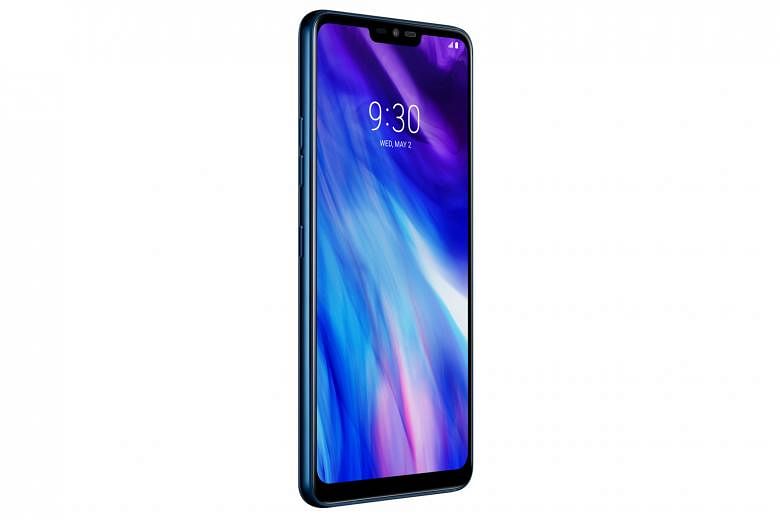LG's latest G7+ ThinQ smartphone is a perfectly serviceable 2018 flagship, checking off all the latest trends: the latest processor, a notched display, dual rear cameras and artificial intelligence (AI) bells and whistles.
However, it finds itself in an odd position of being a well-rounded and extremely good phone, but without any standout features for consumers to get excited about.
It is only a minor upgrade over its G6 predecessor and close-cousin V30+ which were released last year - and that makes its high $1,198 price tag its weakest point.
It is LG's prettiest phone in years, with a smooth, polished glass-and-metal build that oozes premium vibes. It is also one of the lightest flagships - weighing 162g - in the market, compared with the 189g Samsung Galaxy S9+ or 180g Huawei P20 Pro, which have similar screen sizes and build material.
The G7+ has a 6.1-inch LCD screen, unlike the brighter Oled screens in Samsung phones. But itovercomes the problem of not being able to see the screen under bright sunlight with a new Super Bright mode, which cranks up the phone's brightness to Oled-like levels.
It sports a notch at the top of the display, following the trend set by Apple's iPhone X last year. LG insists on calling the sliver of display that flanks the notch a "second screen", which displays the time, battery and connectivity, but it is still a notch.

-
SPECS
-
PRICE: $1,198
PROCESSOR: Qualcomm Snapdragon 845 (Quad-core 2.8GHz and Quad-core 1.7GHz)
DISPLAY: 6.1-inch QuadHD+ LCD, 3,120 x 1,440 , 564 ppi pixel density
OPERATING SYSTEM: Android 8.0
REAR CAMERAS: 16MP wide, f/1.9; 16MP standard, f/1.6
FRONT CAMERA: 8MP, f/1.9
MEMORY: 128GB (microSD expandable up to 2TB), 6GB RAM
BATTERY: Non-removable 3,000 mAh
-
RATING
-
FEATURES: 5/5
DESIGN: 5/5
PERFORMANCE: 5/5
BATTERY LIFE: 4/5
VALUE FOR MONEY: 4/5
OVERALL: 5/5
If you have an aversion to the look of the notch, there is an option of making it appear to switch off by changing the background to a stark black. Unfortunately, since the screen is an LCD display and not an Oled one, it cannot display true blacks, so you will see a noticeable contrast between the notch and the screen.
A dedicated button on the left of the phone to open up Google Assistant is convenient for heavy users of the feature. Those who want to disable the button can also do so.
LG's attempt at doing something new with the G7+ lies in its new AI features, which fits the ThinQ branding the company debuted earlier this year.
With the G7+, the AI features centre on the camera.
Included in the default camera app is LG's AI Cam feature, which reads the scene you are trying to shoot and matches it to one of 19 modes that range from food to scenery to text. Each mode comes with the colour, contrast and saturation settings that best suit it.
It does not always get it right. Leaving the AI to decide how best to adjust a photo could result in odd results, like a photo of my eggs Benedict with hollandaise sauce looking like a glowing, radioactive lump.
The default camera app also integrates Google Lens, an image-recognition and search software. This makes it convenient to use Lens, instead of having to activate Assistant and then hit the Lens option to use it.
LG continues to maintain a dual-camera set-up comprising a standard-angle camera and a wide-angle one, instead of a secondary telephoto lens most other manufacturers have opted for.
Photo quality is overall on a par with those from other flagships in today's market, but loses out in resolution and detail due to the G7+'s smaller sensor size.
The G7+ has a new Super Bright camera mode for low-light photography that amps up the brightness of pictures taken in near-darkness. However, I find shots taken in this mode unnaturally bright and not representative of the scene at hand.
Eschewing a telephoto lens normally means giving up on the ability to shoot bokeh - the soft, out-of-focus background effect.
The G7+ has a new Portrait Mode which digitally simulates bokeh. But this mode tends to blur the sides of the subject along with the background, so you might sometimes end up with fuzzy ears or hair when these should be in focus as well. Thankfully, such instances are rare.
The G7+ will continue to be an audiophile favourite because it retains the 3.5mm audio jack and LG's hi-fi quad digital-to-audio converter, which lets the phone drive high-end headphones really well.
There is also a new "Boombox" feature that amps up the bass when the phone is playing audio while lying on a flat surface. The effect is not that noticeable though because the phone's speakers are already quite loud.
The phone has a smaller battery than last year's G6 and V30+ smartphones. While packing a smaller 3,000mAh battery is probably one reason how the G7+ manages to be so light and svelte, the battery drain is noticeable as I found myself reaching to charge the phone more often.
I would prefer a larger battery - and more battery life - even if it makes the phone slightly heavier.
• Verdict: The LG G7+ ThinQ is LG's best phone in years, but its high price tag and lack of standout features might make it a tough sell. With a snappy processor, versatile camera and good build quality, the G7+ is a good all-round performer.


